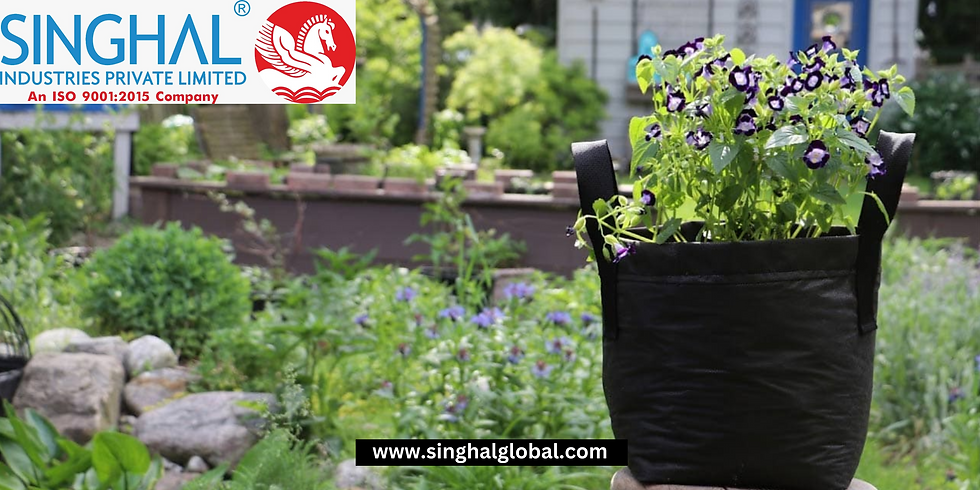Everything You Need to Know About Grow Bags for Indoor and Outdoor Plants
- Singhal Industries Private Limited
- Aug 28, 2024
- 3 min read
Grow bags are versatile containers used for growing plants. Made from various materials like fabric, plastic, or biodegradable substances, Fabric bag manufacturers in India offer a practical solution for gardening, especially in limited spaces. These bags help in optimizing root growth and improving overall plant health.
Importance of Grow Bags in Gardening
Grow bags are essential in modern gardening for their ability to enhance root aeration, manage soil moisture, and provide a flexible growing environment. They are particularly useful for urban gardeners and those with small spaces.
Types of Grow Bags
Fabric Grow Bags
Fabric grow bags are made from breathable materials that allow for excellent air circulation and root pruning. They are ideal for growing vegetables, herbs, and flowers and are known for their durability and ease of use.
Plastic Grow Bags
Plastic grow bags are durable and cost-effective. They retain moisture well but may not offer the same level of aeration as fabric bags. They are suitable for a variety of plants and are easy to clean and reuse.
Biodegradable Grow Bags
Biodegradable grow bags are made from natural materials that decompose over time. They are an eco-friendly option that provides the benefits of traditional grow bags while minimizing environmental impact.
Benefits of Using Grow Bags
Improved Root Health
Grow bags promote healthier root systems by providing better aeration and preventing root circling. This leads to stronger, more vigorous plants.
Space Efficiency
Grow bags are perfect for small spaces as they can be easily moved and arranged. They also allow for vertical gardening, maximizing space usage.
Enhanced Drainage and Aeration
The breathable material of grow bags ensures proper drainage and aeration, reducing the risk of waterlogging and root rot.
How to Choose the Right Grow Bag
Size and Capacity
Select a grow bag size based on the type of plant and its growth requirements. Larger bags are suitable for root vegetables and shrubs, while smaller bags work well for herbs and annuals.
Material and Durability
Choose a material that suits your gardening needs. Fabric bags offer breathability and longevity, while plastic bags are sturdy and easy to maintain.
Design Features
Look for features like handles for easy transport, reinforced seams for durability, and drainage holes to ensure proper water flow.

How to Use Grow Bags
Preparing the Grow Bag
Before planting, ensure the Garden bag for planting is properly prepared. Fill it with high-quality potting mix and ensure it has adequate drainage.
Planting Techniques
Follow proper planting techniques, including spacing plants correctly and providing support if needed. Water plants thoroughly and monitor their growth.
Maintenance and Care
Regularly check for pests and diseases. Water the plants as needed and ensure the grow bag remains in good condition.
Expert Tips and Tricks
Best Practices for Optimal Growth
Use a well-balanced potting mix and avoid overwatering. Regularly prune plants to encourage healthy growth.
Common Mistakes to Avoid
Avoid using heavy soil that can hinder drainage and root health. Ensure the grow bag is not placed in direct sunlight for extended periods.
Seasonal Considerations
Adjust watering and care routines based on seasonal changes. Protect plants from extreme temperatures and provide shade as needed.
Future Trends in Grow Bags
Innovations in Materials
Future developments may include advanced materials that offer better insulation, durability, and environmental benefits.
Eco-Friendly Alternatives
The rise of eco-friendly grow bags made from recycled or biodegradable materials aligns with growing environmental awareness.
Smart Grow Bags and Technology
Emerging technologies may incorporate sensors and automation to optimize Garden bag planters supplier conditions and enhance plant care.
Conclusion
Grow bags offer a flexible and efficient solution for gardening, providing benefits like improved root health, space efficiency, and enhanced drainage. Choosing the right bag and using it correctly can significantly impact plant growth. Consider your specific gardening needs and select a grow bag that meets those requirements. Stay informed about new trends and innovations to make the most of your gardening efforts.
Frequently Asked Questions (FAQs) About Grow Bags
How often should I water plants in grow bags?
Watering frequency depends on the plant type and environmental conditions. Fabric grow bags typically need more frequent watering due to their high drainage. Check soil moisture regularly and water when the top inch is dry.
Can grow bags be used for indoor plants?
Yes, grow bags can be used for indoor plants. They are particularly useful for indoor gardening as they are portable, easy to move, and provide excellent drainage, which is beneficial for indoor plants.
What are grow bags used for?
Grow bags are used for growing plants in a flexible, portable container. They are ideal for vegetables, herbs, flowers, and shrubs. Grow bags provide excellent aeration and drainage, which promotes healthier root systems and more robust plant growth.



Comments